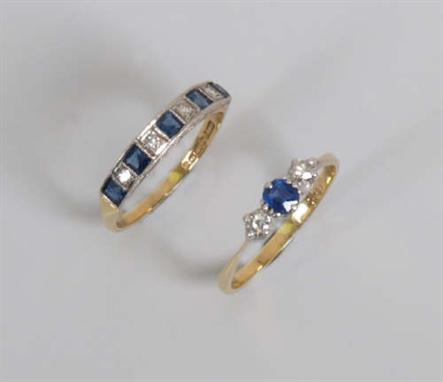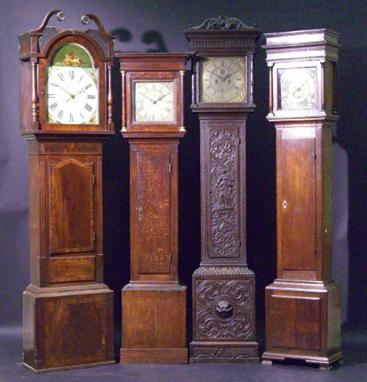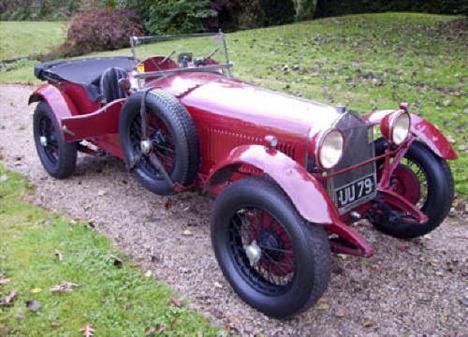Three 9ct gold rings to include an oval top faceted rubellite set ring flanked either side by a round brilliant diamond, a step cut pink topaz set ring flanked either side by white topaz set shoulders and an alexandrite cluster ring. All three rings are in generally good condition. There are some minor scratches to the gold, however nothing serious. There are visible inclusions to the top faceted rubelite, these are easily visible without magnification..
We found 26534 price guide item(s) matching your search
There are 26534 lots that match your search criteria. Subscribe now to get instant access to the full price guide service.
Click here to subscribe- List
- Grid
-
26534 item(s)/page
Edwardian diamond and green paste set carved half hoop ring with four graduating green paste step cut stones interspaced by old cut diamonds. Hallmarked Chester 1904. The ring is in a reasonable condition as the green pastes stones are abraded, the diamonds are bright and there are a few minor scratches and dents from general wear and tear to the shank. Finger size UK R, US 8.75.
14ct gold emerald and diamond bar brooch with a central cluster comprising an old European diamond surrounded by four step cut emeralds and four diamonds with alternate graduating emeralds and diamonds to the arms, approximate total diamond weight 1.42ct, clarity SI1, colour H/I. Brooch in generally good condition, some minor scratches from wear and tear. Emeralds have slight abrasion to the facet edges, diamonds are bright and lively.
Five rings, to include a 9ct gold nine stone split pearl ring, a 9ct gold opal and sapphire cluster ring, with a central circular opal followed by open work design and a final surround of thirteen sapphires, a rectangular step cut synthetic ruby set ring, a 9ct gold signet ring with a central star set round brilliant diamond and one other ring. The lot is in a generally good condition, there is slight abrasion to some of the sapphires and minor blemishes to the cultured pearls, all the rings have minor scratches and dents from general wear and tear.
Diamond and emerald cocktail ring with central round brilliant cut diamond with a step cut emerald either side, a circular line of four round brilliant cut diamonds to top and bottom and further diamond details to shoulders. Total estimated diamond weight 1.05cts-centre stone 0.65cts. In general good condition though one of the outer diamonds is chipped/abraded. The diamonds are bright and have SI1/SI2 clarity, the centre stone is drawing colour. Emeralds are quite an attractive green. Ring size UK J and 1/2, US 5.
18ct white gold ruby and diamond ballerina style cluster ring with central oval ruby surrounded by eighteen step cut diamonds of varying sizes. In good general condition. Ring hallmarked 18ct gold, Sheffield 2004 and with maker's mark EGM. The diamonds are quite bright but of Pique clarity and one or two have external damage. The central ruby is heavily included. Ring size UK O, US 7.
Platinum sapphire, emerald and diamond cocktail cover watch, the cover with a central sapphire surrounded by square step cut emeralds, four eight cut diamonds in an open work design and to the outer edge alternating four diamonds and four step cut sapphires opening to reveal a silver face with black Arabic numerals on an expandable bracelet.
A pair of Georgian cut glass decanters, each with a hobnail band above horizontal banding and vertical flutes, the necks with step cutting beneath cushion hobnail cut stoppers, height approx 25cm (minor chips) together with another pair of later diamond cut shaft and globe decanters and stoppers.
CHRISTOPHER STOATE: TAXIDERMY THE REVIVAL OF A NATURAL ART, 1987, 1st edn, sgnd and dedicated, orig cl d/w + GERALD J GRANTZ: HOME BOOK OF TAXIDERMY AND TANNING, Pennsylvania 1969, orig cl d/w + WADDY F McFALL: TAXIDERMY STEP BY STEP, Oklahoma 1975, orig cl d/w + JOHN W MOYER: PRACTICAL TAXIDERMY, NY 1953, orig cl gt + RUSSELL TINSLEY: SHOOTER’S BIBLE TAXIDERMY GUIDE, New Jersey 1967, orig pict wraps + JOHN C METCALF: TAXIDERMY A COMPLETE MANUAL, 1981 1st edn, orig pict wraps (6)
Rey (Guido), The Matterhorn, with An Introduction by Edmondo De Amicis, trans. J.E.C. Eaton, 2nd ed., Fisher Unwin, 1908, half-title, tipped-in plts., orig. cloth, rubbed and stained, rebacked with portion of orig. spine laid-down, 4to, together with King (Clarence), Moutaineering in the Sierra Nevada, Sampson Low, 1872, ads. at rear, lacking half-title (?), orig. cloth, some wear, rebacked with portion of orig. spine laid-down, 8vo, plus Ridgeway (Rick), The Last Step, the American Ascent of K2, Mountaineers Books, 1999, orig. cloth in d.j., 8vo, together with a qty. of others, misc. mountaineering (3 shelves)
Posters, a selection of 12 early Royal Society For The Prevention Of Accidents examples, the first 6 examples measure 10" x 15" and all printed by Loxley Brothers Ltd. And believed to be 1940's. 1. Look Out For Pedestrian Crossings. 2. Make Sure You Stop - Before Opening Door - Watch Out For Others. 3. Keep Well To The Left. 4. Cyclists Keep Them Clean - Make Sure You Are Seen. 5. Dip Those Lights - If Dazzled Slow Down. 6. Return Your Indicator After Signalling. All are colour and in extremely good condition. The next 6 examples measure 20" x 15". (1) In The Country Listen & Look Before You Cross The Road. (2) Never Play Near The Road. (3) Cars Go Faster Than You Think - Always Do Your Kerb Drill. (4) Cyclists- Concentrate & Anticipate. (5) Cyclists Overtaking Drill. (6) Wait Until There Is Room - Don't Step Into The Road. Most have some edge loss/repair but a fine selection that we all remember from our schooldays.
A mid 18th century oak longcase clock, having a step cornice and plain frieze above a square brass dial, width 11Ó, the silver chapter ring having Roman numerals, signed to the centre George Washbourn of Gloster (sic), single blue steeled hand and cast brass mask corner spandrals, thirty hour weight driven movement striking on a bell, the trunk with plain panelled door on a box base, height 191cm (Illus.)
1929 ALFA ROMEO 1750 SUPER SPORT EX-BORIS IVANOWSKI 1929 IRISH GP WINNER Estimate £400000 - 450000 Registration Number UU 79 Chassis Number 0312909 Engine Number 0312909 Engine Capacity 1752 Paint Colour RED Trim Colour BLACK MOT Expiry Date T.B.A. When Vittorio Jano defected from FIAT to Alfa Romeo at the end of the 1923 season he effectively caused the contemporary Grand Prix formbook to be rewritten. Among the most gifted automobile engineers of the twentieth century, his first Alfa Romeo model - the legendary P2 - comfortably outclassed its Bugatti, Delage and Sunbeam opposition. Winner of both the European and Italian GPs in 1924 (a feat it repeated the following year en route to securing the inaugural AIACR World Championship for Manufacturers), the supercharged two-seater was still collecting silverware some six years later - as witnessed by Achille Varzi's sensational 1930 Targa Florio victory. However, there was far more to Jano's genius than just competition cars.Introduced at the April 1925 Milan Motor Show but not released to the public for another two years, the Alfa Romeo 'NR' (later rechristened the '6C-1500') boasted an enviable specification. Derived from that of the P2, its channel-section pressed-steel ladder-frame chassis was equipped with all-round semi-elliptic leaf-sprung suspension and four-wheel drum brakes. Notably smooth, flexible and free-revving, the model's 'clean sheet' 1487cc straight-six engine made artful use of aluminium-alloy (crankcase, sump) and cast-iron (cylinder block / head). Initially available in single overhead-camshaft guise only, this 'base' unit was soon augmented by an assortment of normally aspirated and supercharged 'twin-cam' variants as Jano sought to ensure class-leading performance.Hand-built to exacting standards and often clad with bespoke coachwork, the 6C-1500 was predictably expensive. Keen to boost sales, Alfa Romeo embarked on an active competition campaign. While 1927 witnessed a number of domestic successes, it was not until the supercharged cars came on stream that the 6C-1500 really started to establish an international reputation. As well as being driven to victory on the Mille Miglia by Giuseppe Campari and Giulio Ramponi, 1928 also saw force-fed 6C-1500s scoring wins in the hands of such luminaries as Enzo Ferrari (Circuito di Alessandria, Circuito di Modena) and Constantino Magistri (Giro di Sicilia). Yet by the season's end, the Alfa driver on form was undoubtedly Boris Ivanowsky. Not content with winning the Spa 24-hours, the former Russian Imperial Guardsman also dominated that year's Coupe Georges Boillot and Circuit des Routes Pavées.Debuting at the February 1929 Rome Motor Show, the 6C-1750 was intended to keep Alfa Romeo one step ahead of the competition. Nigh-on identical to its 6C-1500 sibling (save for an engine capacity increase to 1752cc), the newcomer offered a similar choice of wheelbase lengths and single overhead-camshaft or 'twin-cam' powerplants. Though, from a racing standpoint the 'SS' (or 'Super Sport') remained the most desirable derivative combining as it did the lightest chassis with the most powerful engine. A point reinforced in April 1929 when Campari and Ramponi piloted one to their second successive Mille Miglia victory (indeed blown 6C-1750s took seven out of the top ten places that year).As head of Alfa Romeo (British Sales) Ltd, F.W. Stiles was understandably eager to raise the marque's UK profile. In addition to running his own team of factory-backed 6C-1500 SS racers during the 1929 season, he offered support services to the 'privateer' 6C-1750 SS racers of Leonard Headlam and Dr. J. Dudley Benjafield. Naturally, Stiles extended the same courtesy to the Hon. Anthony Brunner when the latter purchased chassis number 0312909 in June that year (though, intriguingly there is no record that Alfa Romeo (British Sales) Ltd supplied the car). Road registered as 'UU 79' not long after, the
1905 RUDGE-WHITWORTH GENTS ROADSTEREstimate £500 - 600 Part of a private collection this cycle has said to have been stored for many years after a period of careful use and has since been sympathetically been restored. It has a 25" frame and is fitted with 28x1 1/2" wheels, original B.E. tyres with new inner tubes, flat bars with inverted levers, concealed cables linked with rod brakes, original headstock badge, 9" chain wheel and rear mounting step.
1878 COVENTRY MACHINIST CO. ORDINARY BICYCLEEstimate £2300 - 2500 The cycle trade in Coventry grew out of the Coventry Sewing Machine Company, founded in 1863, which was finding it difficult to expand and decided to diversify. In 1868, their Paris agent obtained an order for 400 velocipedes to be exported to France, but the Franco-Prussian War forced the company to build up a home market instead and in 1869 the name was changed to the Coventry Machinist Company.. At this time, James Starley was foreman of the company and was instrumental in helping bring about several improvements to the basic Velocipede. However, in 1870 he left to set up business with William Hillman with whom he produced the Ariel.Part of a private collection this example has a 48" driving wheel (which has been re-spoked and has a new tyre), 18" rear wheel with mounting step, 20" straight handle bars and moulded sockets to the forks for the fitting of foot rests which where an optional extra..
1994 RANGE ROVER SE TOWNLEY STRETCH LIMOUSINE EX SULTAN OF BRUNEI FAMILY & 14K MILES Estimate £24000 - 28000 Registration Number L23 PWT Chassis Number SALLHBM33MA648288 Engine Number N0D09761B Engine Capacity 4275 Paint Colour BLACK Trim Colour RED MOT Expiry Date APRIL 2007 One of the few truly 'classless' cars of recent times, the Range Rover was the brainchild of famous Rover engineer Spen King. The idea was simple yet brilliant - to take the supreme off-road ability of the Land Rover and marry it to the comfort and refinement of the Rover saloons to create a truly multi-purpose vehicle. Yet few could have foreseen just how successful the Range Rover would be at marrying these opposing qualities. Launched in June 1970 with a practical yet stylish 3-door station wagon body and powered by the sinewy ex-Buick 3.5 litre V8 engine the Range Rover was an instant hit with both farmers and the Chelsea set alike. Throughout the 1970s demand far outstripped supply and during the 1980s further development saw the introduction of a 4-door model, automatic gearbox and a Turbo Diesel engine to ensure that the Range Rover always stayed one step ahead of pretenders such as the Mercedes-Benz G-Wagen and myriad Japanese off-roaders from Nissan, Toyota & Mitsubishi.However, this particular black Range Rover is no ordinary 4x4. Originally ordered by the Sultan of Brunei for his younger brother Prince Jefri, the car was converted by Townley 4x4 (coachbuilders to The Queen) at a total cost of £139,000 and features 2 additional centre doors with strengthened chassis, raised roofline with laminated sunroof, darkened windows and one piece opening rear tailgate. Having a central full electric division the red Bridge of Weir leather interior has three rear seats (2 electrically operated) and includes such luxuries as full air conditioning, stereo/CD player and two remote control 8" television sets with video recorder. Fitted with 4.3 litre V8 engine and automatic gearbox the car has covered only 14,000 miles from new, a figure guaranteed correct by the vendor. Described as 'A1+' condition in all aspects by the vendor this particular car found fame when it was used to ferry Mike Tyson around Glasgow when he fought at Hampden Park in July 2000 (copy period news reports on file).
A pair of Art Deco emerald and diamond pendent earrings, each with an old-cut diamond collet surmount suspending an articulated eight-cut diamond baton and collet intersection and drops in the form of similarly set graduated arches and rectangular step-cut emerald collets, each approximately 42mm long overall
-
26534 item(s)/page









































